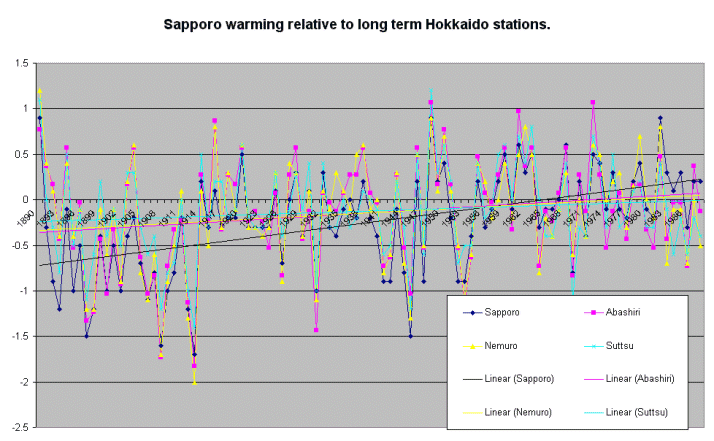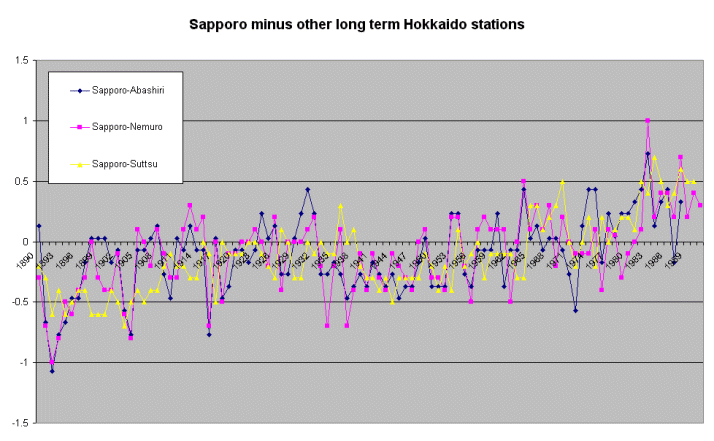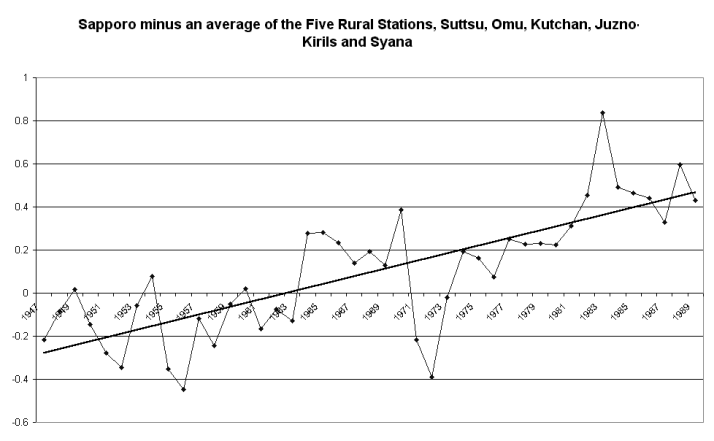
Sapporo
Urban Heat Island growth and growth trends in Japanese skiing.
This week we look at temperature trends on the northern Japanese island
of Hokkaido.
CRU used five records from Hokkaido: the city of Sapporo (population 1.24
million in the GHCN database) and the small centres of Wakkanai (55,000),
Abashiri (44,000), Nemuro (46,000) and Urakawa (20,000).
CRU looked at and rejected two other stations, Haboro (14,000) with data from 1951, and Asahikawa, a town of 320,000 with data from 1889. CRU's notes on Asahikawa mention a warming trend of 1 degree C which they describe as "....possibly urban warming. Could also be due to several height & observing time changes."
This gives an impression that CRU has the magnifying glass out looking for urban warming. Yet, as we shall see, they went ahead and included Sapporo, a city three times the size of Asahikawa, and which warms at a much greater rate.
The only way of assessing the accuracy of the CRU results is compare their data with those from rural stations undisturbed by urban heating effects. Fortunately these do exist. The GHCN has three rural records (= less than 9,000 pop.) from Hokkaido – Suttsu, Omu and Kutchan – and two further rural data sets from Russian-controlled islands off the eastern tip of Hokkaido, Juzny-Kirils and Syana. Of these five, Suttsu is the only long-term record, with data back to 1889.
First let us compare all the long-term records in the region to assess the differences between rural and urban stations. The graph below compares all the data from Sapporo, Wakkanai and Urukawa, included in the CRU database, with those from Suttsu, the rural station they left out. The variations are standardised on the 1950-80 average for each station so as to give a clearer idea of trends.
The graph shows that Sapporo warms at about 0.9 degrees C over the 98 years, Abashiri 0.45 degrees, Nemuro about 0.4 degrees, and Suttsu about 0.25 degrees. Note that the Sapporo data includes a CRU pre-1939 correction for a site change of just over 0.5 degrees. This removes some of the warming but as the graph shows, Sapporo still has the biggest warming trend among the Hokkaido stations.

Let us now look at the trend differences between Sapporo and the other
three stations. The graph below shows marked variations in the rate
of Sapporo warming relative to its neighbours over the hundred years.
Note the early warming, which may reflect population growth in Sapporo in
the early years of Japan's industrial expansion. By 1938, Sapporo had
a population 210,000. The data are choppy in the 1930s, which may reflect
site changes. The war and its aftermath are a period of no relative
warming in Sapporo. With increasing prosperity in the sixties and the
development of the skiing industry, Sapporo again warms strongly relative
to its smaller neighbours. Sapporo hosted the Winter Olympics in 1972.

The last graph below shows Sapporo warming by an average of 0.17 degrees per decade from 1946 to 1989 relative to the average of the rural stations Suttsu, Kutchan, Omu, Juzno-Kirils and Syana. The UHI at Sapporo in recent decades looks to be growing at twice the rate of century-long “global warming”. This acceleration in warming is seen in some of my other case studies, e.g. Sydney and Atlanta.
Footnote on population data: One of the problems with the GHCN
is that its population statistics are out of date. Sapporo is still
listed there as having a population of 1.24 million. The International
Geographic Encyclopedia and Atlas, 1979 edition, already gave an estimate
of 1.27 million for 1976. The Sapporo authorities estimated its population
as 1.8 million in 1998.

Posted 16, June, 2000, re-written 23, June, 2001
You saw it first here
© Warwick Hughes, 2000-2001
Back to Cities List
Back to Front Page